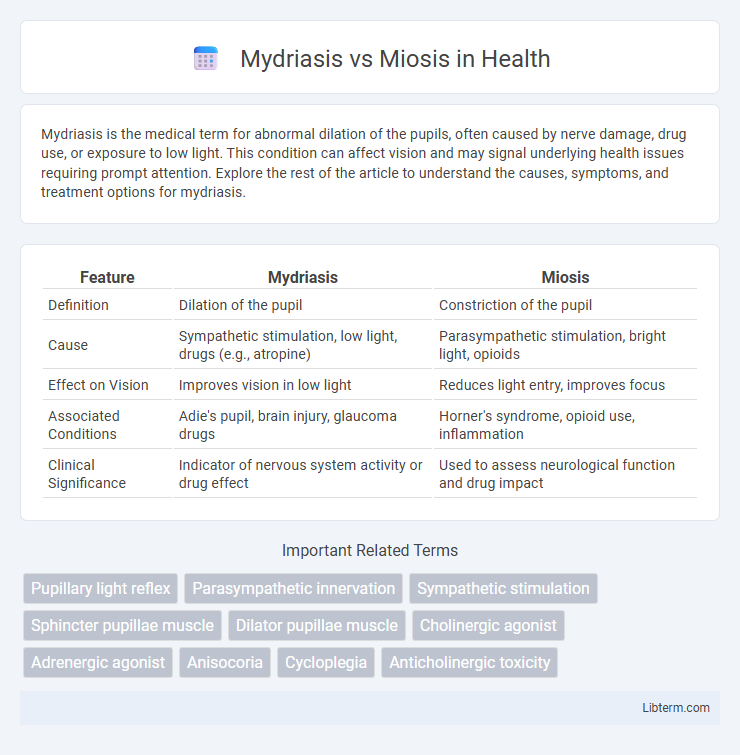Mydriasis is the medical term for abnormal dilation of the pupils, often caused by nerve damage, drug use, or exposure to low light. This condition can affect vision and may signal underlying health issues requiring prompt attention. Explore the rest of the article to understand the causes, symptoms, and treatment options for mydriasis.
Table of Comparison
| Feature | Mydriasis | Miosis |
|---|---|---|
| Definition | Dilation of the pupil | Constriction of the pupil |
| Cause | Sympathetic stimulation, low light, drugs (e.g., atropine) | Parasympathetic stimulation, bright light, opioids |
| Effect on Vision | Improves vision in low light | Reduces light entry, improves focus |
| Associated Conditions | Adie's pupil, brain injury, glaucoma drugs | Horner's syndrome, opioid use, inflammation |
| Clinical Significance | Indicator of nervous system activity or drug effect | Used to assess neurological function and drug impact |
Introduction to Mydriasis and Miosis
Mydriasis refers to the dilation of the pupil, typically caused by reduced parasympathetic stimulation or increased sympathetic activity, resulting in enlarged pupils that allow more light to enter the eye. Miosis is the constriction of the pupil, often triggered by parasympathetic activation or exposure to bright light, leading to smaller pupils that regulate light intake. Both pupillary responses are crucial for controlling the amount of light reaching the retina and protecting the eye under varying environmental conditions.
Definition and Overview
Mydriasis is the medical term for pupil dilation, characterized by the enlargement of the pupil in response to low light or certain medications. Miosis refers to the constriction of the pupil, resulting in a smaller pupil size typically caused by bright light exposure or parasympathetic nervous system activation. Both conditions are controlled by the iris muscles, playing crucial roles in regulating the amount of light entering the eye and affecting visual acuity.
Anatomical Basis of Pupil Size Changes
Mydriasis involves the dilation of the pupil primarily due to sympathetic nervous system activation stimulating the dilator pupillae muscle of the iris. Miosis is characterized by pupil constriction driven by parasympathetic nervous system activation causing contraction of the sphincter pupillae muscle. These autonomic innervations regulate pupil size by controlling iris muscle tone in response to light intensity and emotional states.
Causes of Mydriasis
Mydriasis, characterized by pupil dilation, occurs due to factors such as sympathetic nervous system stimulation, certain medications like anticholinergics and sympathomimetics, and neurological conditions including brain injury or increased intracranial pressure. Contrastingly, miosis involves pupil constriction, often caused by parasympathetic activation, opioid use, or exposure to toxins like organophosphates. Understanding the underlying causes of mydriasis is crucial for diagnosing neurological disorders and managing drug effects effectively.
Causes of Miosis
Miosis is primarily caused by increased parasympathetic stimulation leading to pupillary constriction, commonly linked to conditions such as opioid use, pontine hemorrhage, and exposure to organophosphates or cholinergic drugs. This excessive activation of the sphincter pupillae muscle results in a characteristic pinpoint pupil often seen in opioid intoxication and certain neurological disorders. Understanding the distinct etiologies of miosis is crucial for accurate diagnosis and treatment in clinical ophthalmology.
Clinical Significance and Implications
Mydriasis, characterized by pupil dilation, often indicates sympathetic nervous system activation or underlying conditions like brain injury, drug influence, or increased intracranial pressure, requiring urgent evaluation. Miosis, marked by pupil constriction, can signal opioid use, pontine hemorrhage, or Horner's syndrome, aiding clinicians in diagnosing neurological or toxicological states. Accurate differentiation between mydriasis and miosis is critical for assessing patient consciousness, neurological function, and guiding emergency management strategies.
Common Symptoms and Associated Conditions
Mydriasis, characterized by pupil dilation, commonly presents with symptoms such as sensitivity to light, blurry vision, and difficulty focusing, often associated with conditions like brain injury, drug intoxication, or sympathetic nervous system activation. Miosis involves pupil constriction, leading to symptoms such as decreased vision in low light and eye discomfort, frequently linked to opioid use, Horner's syndrome, or exposure to cholinergic agents. Accurate identification of these symptoms aids in diagnosing underlying neurological or pharmacological causes.
Diagnostic Approaches
Mydriasis, characterized by pupil dilation, and miosis, marked by pupil constriction, require distinct diagnostic approaches to determine underlying causes such as neurological disorders, drug effects, or ocular trauma. Comprehensive eye examinations including pupillary light reflex testing, slit-lamp biomicroscopy, and pharmacologic testing with agents like pilocarpine or apraclonidine help differentiate between parasympathetic or sympathetic pathway involvement. Imaging studies, such as MRI or CT scans, are often necessary to rule out structural brain lesions or nerve compression in persistent or unexplained cases.
Treatment and Management Options
Mydriasis treatment involves addressing underlying causes such as trauma, drug effects, or neurological conditions, with options including antidotes for anticholinergic toxicity or use of pilocarpine eye drops to constrict the pupil. Miosis management depends on its etiology, often requiring cessation of opioids or cholinergic agents, while pharmacological interventions like atropine eye drops may be employed to dilate excessively constricted pupils. Both conditions necessitate careful neurological evaluation and tailored therapy to prevent complications such as vision impairment or increased intracranial pressure.
Mydriasis vs Miosis: Key Differences and Summary
Mydriasis refers to the dilation of the pupil, often caused by low light, drug effects, or neurological conditions, while miosis is the constriction of the pupil typically triggered by bright light or the activation of the parasympathetic nervous system. Key differences include their physiological triggers, underlying mechanisms, and clinical implications; mydriasis involves sympathetic stimulation or parasympathetic inhibition, whereas miosis results from parasympathetic activity. Understanding these distinctions aids in diagnosing neurological disorders, assessing drug effects, and managing ocular health effectively.
Mydriasis Infographic

 libterm.com
libterm.com